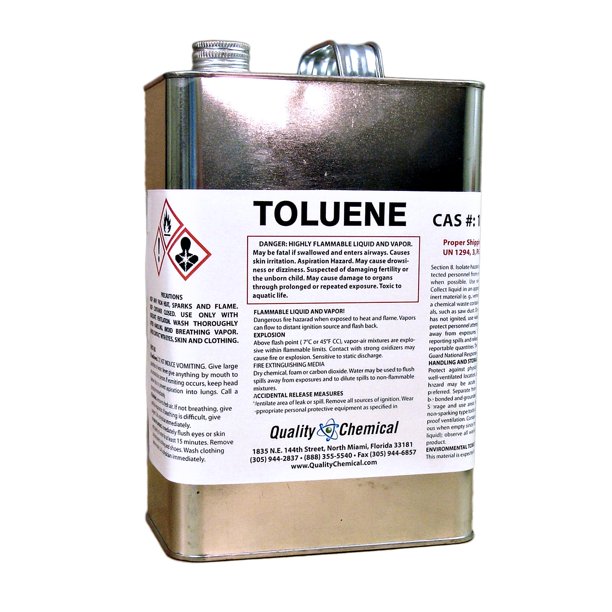The boiling point of a substance is a measure of the temperature at which it changes state from liquid to gas. It is an important physical property that can be used to identify and classify substances. Toluene is a clear, colorless liquid with a characteristic aromatic odor and has a boiling point of 110-111°C (230-232°F).
Toluene is an organic compound found in many commercial products such as paint thinners, nail polish remover, glues, and correction fluid. Its boiling point is higher than other similar hydrocarbons like benzene due to its larger molecular size. This means that it takes more energy to separate the molecules and vapourise them, resulting in a higher boiling point.
The heat of evaporation for toluene is 38 KJ/mol which indicates the amount of energy required for one mole of the substance to change from liquid to gas. The heat of fusion for toluene at -139.3°F (-95.2°C) is 6.6 KJ/mol which indicates the amount of energy required for one mole of the substance to change from solid to liquid state.
The specific heat capacity (Cp) for gas phase toluene at 103.7 J/gK provides information about how much energy needs to be supplied or removed in order for 1 gram of the material’s temperature to change by 1 Kelvin degree. This property can be used in various applications such as calculating thermal conductivity values or predicting changes in temperature during chemical reactions.
In sum, understanding physical properties like boiling point are essential when assessing materials prior to use in industrial processes or consumer goods formulation. Knowing tese properties enables engineers and scientists alike to design safer products that meet quality standards while avoiding hazards such as flammability or toxicity risks associated with certain materials like Toluene.
The High Boiling Point of Toluene
Toluene (C7H8) has a higher boiling point than benzene (C6H6) due to stronger intermolecular forces. The larger size of the toluene molecule results in increased van der Waals attractions between molecules, requiring the input of more energy to separate and vaporise them. Additionally, the greater number of electrons in the toluene molecule leads to increased London dispersion forces and dipole-dipole interactions between molecules, further increasing the energy required for vaporisation. This additional energy is what gives toluene its higher boiling point compared to benzene.

The Benefits of Toluene as a Solvent
Toluene is an excellent solvent because it has a low polarity which allows it to dissolve a wide range of organic compounds. It has a higher boiling point than many other solvents, meaning that it can be used in processes that require the use of high temperatures. Additionally, toluene is non-reactive and therefre can be used safely with many different types of compounds without causing unwanted reactions. This makes it suitable for applications such as paint thinners, nail polish remover, glues, and correction fluid where the presence of other compounds may cause problems. Finally, toluene is relatively inexpensive compared to other solvents making it a cost-effective choice in many solvent applications.
Evaporation Temperature of Toluene
Toluene evaporates at its boiling point, which is 111.6°F/44.1°C. The heat of evaporation for toluene is 177 kJ/mol, meaning that at this temperature, it takes 177 kJ of energy to evaporate one mole of toluene. This heat energy comes from the surroundings, which causes the temperature to rise. As more and more energy is added, the temperature continues to rise until it reaches the boiling point and the toluene begins to evaporate.
Flash Point of Toluene
Toluene has a flash point of 40°F (4.4°C). It is a clear, colorless liquid with a characteristic aromatic odor. The flash point is the temperature at which a liquid gives off sufficient vapor to form an ignitable mixture in air near the surface of the liquid.
The Effects of Touching Toluene
If you touch toluene, it can irritate your skin and may cause an itchy rash. In more serious cases, liquid toluene that comes in contact with the skin may cause burning sensations and redness. If the liquid gets into the eyes, it can cause irritation, redness, and even temporary or permanent vision loss. Inhaling toluene vapor can also cause irritation of the eyes, nose, throat, and lungs.
Explosive Properties of Toluene
Toluene is explosive because it is a highly flammable liquid. When vapors of toluene mix with air at room temperature, the mixture can bcome combustible and readily ignite when exposed to heat or sparks. The flash point of toluene is 4.4° C, meaning that it can easily ignite at temperatures not much higher than room temperature. In addition, when exposed to an ignition source, the vapor-air mixture of toluene can produce a large volume of gas in a short period of time, which can result in an explosive release of energy. Therefore, caution must be taken when handling or storing toluene and products containing it.
What Does the Smell of Toluene Imply?
Toluene has a sharp or sweet odor when it is vaporized. It can be likened to the smell of paint thinner, rubber cement, or gasoline. When in liquid form, it does not have a noticeable scent. However, if exposed to air at room temperature, it will quickly vaporize and release its characteristic odor.
The Origin of the Name Toluene
Toluene is called toluene because it was isolated in 1856 by the French chemist Henri Étienne Sainte-Claire Deville from “tolu balsam” (extracted from the Colombian tree Myroxylon balsamum). After a period of debate among chemists, it was decided that this new substance would be called toluene due to its association with “tolu balsam”. Since then, the name of this clear, colorless and volatile hydrocarbon has remained unchanged.
The Origin of the Name Toluene
Toluene is an organic compound with the chemical formula C7H8. It is a colorless, sweet-smelling liquid that is highly flammable and volatile. The name toluene comes from an older name for the compound, toluol, which was derived from the extract of a tropical American tree, Myroxylon balsamum, known as tolu balsam. Tolu balsam has been used in traditional medicine for centuries and was first isolated in its pure form by French chemist Jean-Baptiste Dumas in 1837. In 1841, German chemist Justus von Liebig named it “toluol” after its source. Later, it was renamed “toluene” by French chemist Charles Mansfield in 1861. Toluene has a wide variety of industrial applications such as beng used in the manufacture of paints and coatings, rubber chemicals, pharmaceuticals, dyes and solvents.
Does Toluene Sink or Float in Water?
No, toluene does not sink in water. This is because toluene is less dense than water, meaning it will float on the surface of water. Therefore, it does not sink in water.
The Toxicity of Toluene
Yes, toluene is poisonous and can have serious health effects if it is swallowed, breathed in or comes in contact with the skin. Inhaling toluene vapors can cause irritation of the nose and throat, dizziness, fatigue, headaches and confusion. Ingesting large amounts of toluene can result in nausea, vomiting, abdominal pain and difficulty breathing. Long-term exposure to toluene can lead to liver damage, kidney damage and even death. If you think you have been exposed to toluene or have ingested it, seek medical help immediately.
The Safety of Heating Toluene
No, it is not safe to heat toluene. Toluene is a highly flammable liquid and vapour. When heated, it can ignite and cause a fire or explosion. For this reason, it is important to keep toluene away from sources of heat or ignition, such as open flames or sparks from electrical equipment. Additionally, the vapours from heated toluene can be toxic and inhalation may cause serious health effects.
Is Toluene Use Prohibited?
Yes, toluene has been officially banned as of July 1st, 2021. This ban applies globally and covers the use of toluene in printing, coating, and other industrial processes. Toluene is a volatile organic compound that has been linked to health concerns such as headaches, dizziness, and eye irritation. As such, many countries have decided to phase out the use of this chemical in order to protect public health and safety. Alternative methods are now being used to print and coat materials without the need for toluene, making it a safer option for businesses and consumers alike.
Solubility of Toluene in Water and Oil
Toluene is not soluble in water, but it is soluble in oil. This means that it can mix with oil, but not with water. Toluene has a low solubility in water of approximately 0.25 g/L at 20°C, which is why it does not dissolve easily in water. On the other hand, its solubility in oil is much greater; as a result, its dense components can be easily dispersed in oil and form stable solutions.

Conclusion
In conclusion, toluene has a higher boiling point than benzene due to its larger molecular size and stronger van de Waals intermolecular attractive forces. This property makes toluene an ideal solvent for many organic compounds, such as paint thinners, nail polish remover, glues, and correction fluid. Its flash point is 40°F, and it has a characteristic aromatic odor.
